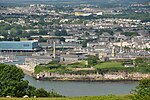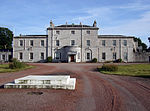Stonehouse Barracks
Barracks in EnglandBuildings and structures in Plymouth, DevonGrade II* listed buildings in DevonRoyal Marines basesRoyal Navy bases in England

Stonehouse Barracks, or RM Stonehouse, is a military installation at Stonehouse, Plymouth. It is the home of 3 Commando Brigade and referred to by commandos as 'the spiritual home of the Royal Marines'.
Excerpt from the Wikipedia article Stonehouse Barracks (License: CC BY-SA 3.0, Authors, Images).Stonehouse Barracks
Barrack Place, Plymouth Stonehouse
Geographical coordinates (GPS) Address Nearby Places Show on map
Geographical coordinates (GPS)
| Latitude | Longitude |
|---|---|
| N 50.36713 ° | E -4.16238 ° |
Address
Barrack Place 12-19
PL1 3RG Plymouth, Stonehouse
England, United Kingdom
Open on Google Maps









